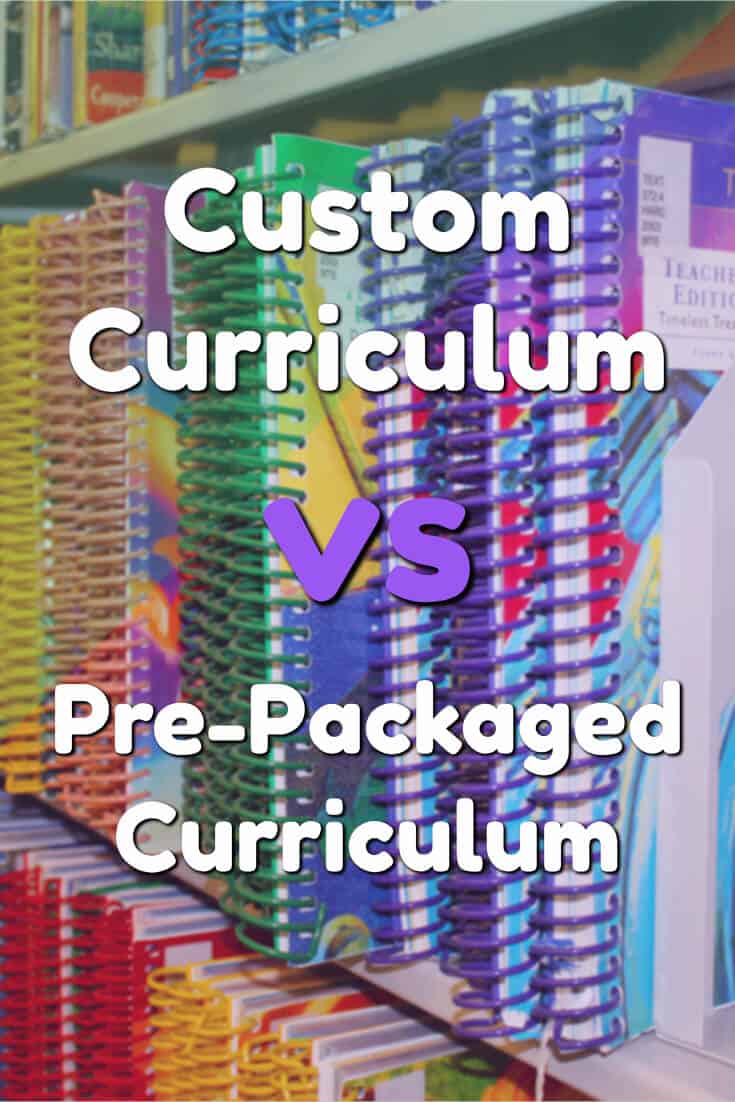Weighing Homeschool Against a Pre-Packaged Curriculum

When you decide that homeschooling is right for your child, you must first decide which type of curriculum you are going to use to teach your child. There are thousands of curriculums on the market today, and the most difficult part of your homeschooling task is to decide which one is best for your child.
From experience, I've found that the daunting task of selecting a curriculum is frequently what causes parents to change their mind about homeschooling altogether.
The first step in choosing your child's curriculum is to weigh your options between a pre-packaged curriculum and a customized curriculum. However, before you can make this decision, you have to know the basic definition of what each one is, and how they work. Let's look at the differences between the two.
What Is a Custom Curriculum?

If you are looking for a curriculum that meets the exact needs of your child, you may like the concept of a custom curriculum. A custom curriculum is designed to meet your child's individual needs. A custom curriculum can be put together from hand-picked materials that when put together meet the standards of the state you live in. The materials chosen are put together in a way for the student's needs to be met, which is something a generalized curriculum plan for the child's grade level cannot do.
What Is a Pre-Packaged Curriculum?
When you look at a pre-packaged curriculum, you are looking at a group of materials that are compiled by a professional. These materials are designed to meet grade level requirements, and subject requirements. You can purchase these pre-packaged curriculums by school year, or by subject. Typically, these packaged materials are age, grade, or subject specific. Since these curriculums are set up specifically and intentionally, you are not really able to modify the learning curve.
One example of a pre-packaged curriculum is an online school that provides all of the materials and textbooks needed. Another example could be Sonlight's comprehensive homeschooling curriculum packages.
Which Curriculum is Better?
Since every child's educational needs are different, there is no set answer to this question. Some children excel on pre-packaged curriculums, while others fall behind or have trouble staying interested. Other children thrive on custom curriculums, especially if they have very narrow interests or a learning disability.
Steps to Determine the Best Curriculum for Your Child
There are some things you can do to determine what works best for your child.
1. Look at your child's previous educational performance.
Have they kept up with their lessons well or have they fallen behind? Does your child have the urge to push ahead of the lessons they are given?
A child who is known for progressing at the same rate as other children in their grade level may benefit from a pre-packaged curriculum. However, a child who soars beyond what is expected of them, or lags behind the standards may require a customized curriculum.
2. Look at your child's development.
If your child has never attended school, this may take more thought than a child who has been to school. When you look at your child's development, have they met all of their milestones on time? Do they catch onto concepts easily or do they need reinforcement and repetition to learn a new skill.
A child who has been behind on a consistent basis will find more benefit in a customized curriculum that can cater to their needs, and help improve areas they have fallen behind. One who has met all of their milestones without assistance may do well on a pre-packaged curriculum. Find out what your child's academic placement should be with Sonlight's Academic Placement Tests.
3. Consider Your Child's Study Habits
When you look at your child's study habits, do you feel they are healthy? Do they understand the information they are studying? Do they become overwhelmed easily during quiet study time?
4. Quiz your child on the information they are reading about to test their comprehension.
Your child does not always have to provide accurate, in-depth detail, but they do need to have a basic concept of what they have just read. If your child is showing a significant deficit in comprehension, a customized plan can help them stay on track, and develop better comprehension skills.
On the other hand, if your child has an amazing sense of comprehension, a pre-packaged plan could provide them a lot of benefit in increasing the comprehension skills they already have.
5. What Does Your Child Think About Homework?
Does your child ask for more school work? Do they ask for extra information and extra research projects that go deeper into the subjects they are learning about? Other children fight against homework. They become frustrated and receive low grades and test scores because of their homework experience. In either of these cases, your child may find more benefit in a customized curriculum.
Is your child excelling with classwork and homework? Do they receive grades of B or higher on their tests and quizzes? If your child only needs a little bit of assistance completing their work, a pre-packaged curriculum may suit their needs.
Positives and Negatives of Pre-Packaged Curriculums
There are many positives and negatives surrounding a pre-packaged curriculum. One of the advantages is that your child's curriculum will always meet the state's required standards. However, if your child requires extra help on a specific topic, the curriculum does not allow for this, unless you carry out this extra help after school hours. The extra help is also not included in the materials you are provided, so you have to go searching for the information yourself. This is a very frustrating situation that parents who follow a pre-packaged curriculum face.
Another well-known negative of purchasing a pre-packaged curriculum is that if your child learns quickly, you may have to buy multiple grade levels of curriculum each year. This can be very expensive, especially if your child absorbs information like a sponge. Since homeschooled children are known for excelling faster than their public school counterparts, they are likely to complete more than one level of educational requirements in a school year and be well above other children in their grade level.
Positives and Negatives to Custom Curriculums
There are a lot of positives and negatives to building a custom curriculum, just like with its counterpart. Children can get more practice in areas they struggle in, and they can excel in areas they are advanced in. You can also mix the grade level of materials from one subject to another.
Custom curriculums can be difficult to write, so if you plan to use one, check out some of the free curriculums online and use them as a template to create your own, or use a free curriculum mapping program.
There are a lot of factors that you can use to choose the curriculum for your child. Regardless of the methods you use to choose your curriculum, your primary objective should be to choose what is best for your child. Keep in mind that if the choice you make does not work for your child, you can always change your mind and use the other option.








Leave a Reply